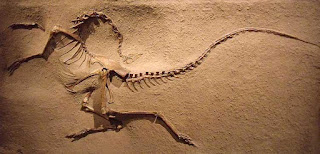Meanwhile, at SBM’s secret headquarters on Skull Island…
(A phone rings and a man sitting at a desk next to a large pile of bitcoins answers.)
“Hello?”
“Gorski. It’s Clay. Here is my post for the day after Thanksgiving. It’s more satire.”
“Again? Sometimes I wish we hadn’t granted you tenure. You know that they won’t be pleased.”
“Dammit Gorski, I’ll promote the drug for whatever new problem the pharmaceutical companies invent this week next time. It’s Thanksgiving!”
(David Gorski hangs up the phone, sighs, and buries his face in his hands.)
Chiropractic paleontologists question mechanism of dinosaur demise
Davenport, IA – Researchers from the Palmer College of Chiropractic Department of Paleontology are questioning the scientific consensus on the demise of the dinosaurs 66 million years ago.

A fossilized Struthiomimus altus, shown here demonstrating a death pose caused by subluxations in the C6 and L5 vertebrae.
“Certainly the 7.5-mile-wide asteroid that crashed near Chicxulub, Mexico played a major role,” Dennis M. Marchiori, D.C., Chancellor of the Palmer College of Chiropractic explained. “But the theory that a massive cloud of dust caused global cooling and wiped out plant life just never made complete sense to us as an ultimate cause of widespread extinction.”
When the team of spine-based paleontologists at Palmer College decided to tackle the enigma of what ultimately resulted in the extinction of the dinosaurs, they were faced with a difficult question. If the dinosaurs weren’t killed by a lack of food or a sudden and drastic change in climate, what could have wiped them out along with 75% of life on Earth? According to lead researcher Frank Grimes, D.C., it turns out that the answer was right in front of them all along.
“The latest computer modeling techniques developed by our colleagues in the computational astrophysics department kept telling us what we already knew couldn’t be true,” Grimes revealed. “It wasn’t until we took a step back and remembered the core tenets of chiropractic science that the answer became clear. Sometimes you can become so bogged down with data that you can’t see the forest for the trees.”
Chiropractic paleontology is a highly specialized field that focuses on the alignment of fossilized spinal bones in order to determine organ system function and the general health of extinct vertebrate species. According to Grimes, the impact from the asteroid undoubtedly caused an immensely powerful shock wave that would have rattled the bones of even the largest creatures on the planet. “In our training, we learn that even minor falls might result in a complex of functional and/or structural and/or pathological articular changes in the spinal column, so just imagine what the force from a 100 million megaton blast might do.”
The impact of the asteroid on the fateful day was felt in every corner of the Earth. Riddled with subluxations of the spine, the days of the dinosaurs were numbered. Chiropractic wouldn’t be discovered for another 66 million years, after all. Grimes, who according to his resume has watched all the Jurassic Park movies at least once, and once thought he found a dinosaur bone but it ended up being the neighbor’s missing Golden Retriever, says not to feel too badly for these prehistoric beasts. “At least we can say that it likely wasn’t a painful extinction. Most of those scaly bastards probably just slipped away quietly in their sleep.”
Behind the blast
My inspiration for posting this bit of satire was the recent announcement of the discovery that dinosaurs, unlike present day reptiles, likely had intervertebral discs similar to humans and other mammals. Modern reptiles at some point appear to have evolved a ball-and-socket type joint between spinal bones, which is more stable and less susceptible to spinal disc herniation. None of this has anything to do with subluxation-based chiropractic pseudoscience of course, but the thought of dinosaurs having less-stable spines naturally took me in that direction.

